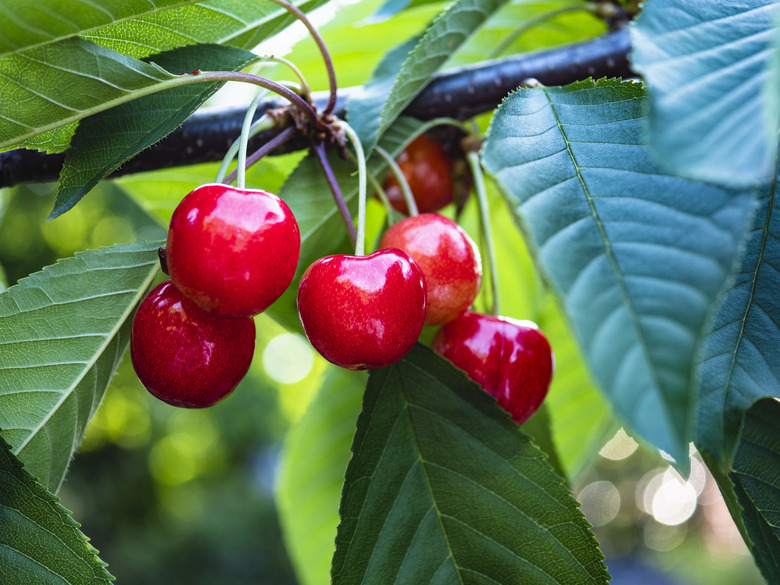How To Grow A Cherry Tree From A Seed Or Pit
We may receive a commission on purchases made from links.
Growing a cherry tree (Prunus spp.) from a seed or pit is easy, but if you want to grow a tree that will yield cherries, there are complications in pollinating your tree and meeting winter chill requirements. Your best bet is to sow cherry seeds from cherries that grew on a locally grown tree or that you bought from a local fruit stand. Cherries sold in supermarkets may come from a tree that is not compatible with your climate, so avoid using these cherry seeds. It's important to note, however, that even if you sow a cherry from a locally grown tree, it may not come true from seed and bear similar fruits.
Sour cherries (Prunus cerasus), also called tart or pie cherries, can reach up to 20 feet tall and grow best in U.S. Department of Agriculture plant hardiness zones 3 through 9, depending on the cultivar. Sweet cherries (Prunus avium) grow 35 feet or taller in USDA zones 3 through 7, depending on the cultivar. Cherry trees need eight hours of sun a day in well-drained soil with a pH of 6.5 to 6.7.
A cherry pit is a hard shell surrounding the seed. Don't try to remove the shell to extract the seed, stratify, and sow the pit. The embryo of a new cherry tree matures inside the pit during winter dormancy, requiring a period of chilling called stratification. To grow trees from seeds through stratification, have the cherry pit outdoors when it's cold or indoors in a refrigerator.
Cherry Pit Stratification
Cherry Pit Stratification
To stratify a cherry pit outdoors, sow it in a furrow no deeper than 1 to 2 times the width of the pit. Cover the pit with soil and put 1 or 2 inches of sand over that to prevent the soil from forming a crust as winter cold stratifies the seed. Do this any time after you pick the cherry; the pit won't germinate and produce a seedling until after it has been stratified.
To prevent squirrels and chipmunks from digging up the pit, place hardware cloth or wire screen over it and push the sides and ends several inches into the soil. Remove the barrier the next spring when the new cherry plant pushes through the soil. Then keep the soil moist, but not soggy, and do not fertilize.
To stratify in a refrigerator, clean the pits of any clinging flesh and let them air-dry. Put them in a glass jar or plastic container with a loose-fitting lid and store them in a refrigerator for 90 to 140 days at a temperature of 33 to 50 degrees Fahrenheit. A 41 F temperature is ideal.
How to Grow Cherry Trees From Pits
How to Grow Cherry Trees From Pits
In the middle of January, place the pit in moist but not wet sand, peat moss, or shredded paper towels, replace the lid and return it to the refrigerator. Remove the pit after at least 60 days. In early spring, sow it in a furrow no deeper than 1 to 2 times the width of the pit. Keep the soil moist but don't let it get soggy. Do not fertilize.
Cherry Tree Pollination Requirements
Cherry Tree Pollination Requirements
All sour cherries are self-fruitful, meaning you can grow one tree from seed and it will bear cherries, but growing trees from seeds of a sweet cherry requires more effort and careful timing. Sweet cherries require pollen from a compatible cherry tree planted within 100 feet.
Cherry tree varieties grow blossoms, produce pollen, and yield cherries at different times. If you sow the seeds of two compatible varieties of sweet cherries to pollinate one another, they have to yield pollen at the same time.
Winter Chill Requirements
Winter Chill Requirements
Cherries grow their fruiting buds in the summer. The buds go dormant in winter and remain that way until they have accumulated enough hours below 45 F. These are called winter chill hours.
Sweet cherries require 700 to 800 hours — about 28 to 32 days — of continuous exposure to temperatures of 45 F or less. Sour cherries require more than 1,200 hours — about 48 days — of continuous exposure to temperatures of 45 F or less.
If a cherry tree doesn't receive enough winter chill hours, it will develop leaves late in the spring growing season and will grow fewer buds needed for cherries the next year. It will also yield fewer cherries of poorer quality. If you get a hold of seeds late in the season, you can try freezing cherries with pits.
